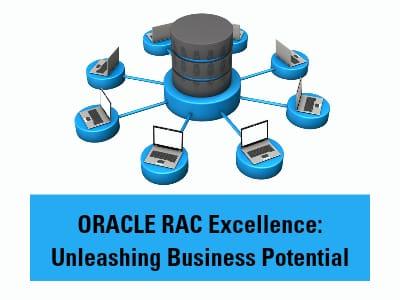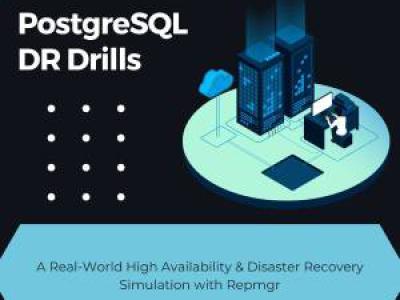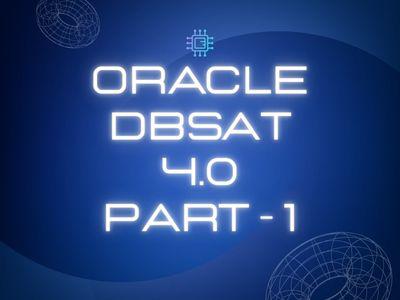- December 26, 2023
by Vasavi Poripireddy - Senior Database Administrator
- Oracle RAC Overview
- Key Features of Oracle RAC
- Implementation at Intrasoft Corporation
- Implementation Process
- Conclusion

Oracle Database provides a full range of capabilities to protect organizations from all causes of system downtimes, both planned and unplanned. Oracle Real Applications Cluster is one most important among them. Oracle RAC is a high-availability database solution that combines the processing power of multiple interconnected computers that allows multiple instances to access a single Oracle database on shared storage. This provides system redundancy, scalability and fault tolerance to ensure the continuous availability of critical business applications.
Oracle RAC is designed to ensure that a database remains operational and available despite hardware failures or planned maintenance activities. In addition, allowing maintenance operations to occur on a subset of components in the cluster, while the application continues to run on the rest of the cluster, can reduce planned downtime.
Key features of Oracle RAC include:
Shared Database:
Oracle RAC allows multiple database instances to run on different nodes of a cluster, all accessing the same physical database stored in shared storage.
High Availability:
If one node or instance in the cluster fails, the workload is automatically transferred to another node, ensuring continuous availability and minimizing downtime.
Scalability:
As the demand for resources grows, additional nodes can be added to the cluster to increase capacity and handle higher transaction loads. This makes Oracle RAC a scalable solution for both small and large databases.
Load Balancing:
Oracle RAC automatically distributes the database workload across all available nodes, preventing any single node from becoming a performance bottleneck.
Fault Tolerance:
The architecture of Oracle RAC includes features such as Oracle Clusterware and Automatic Storage Management (ASM) to monitor the health of nodes and storage. In the event of a failure, the system can quickly and automatically redirect traffic to healthy nodes.
Transparent Application Failover (TFA):
TAF allows client applications to automatically reconnect to another instance in the event of a node failure, ensuring a seamless experience for end-users.
Global Cache Coordination:
Oracle RAC uses a distributed lock manager and cache fusion technology to maintain cache consistency across the cluster. This ensures that each instance has access to the most up-to-date data.
Parallel Processing:
Oracle RAC allows parallel execution of queries across multiple nodes, improving performance for data-intensive operations.
Rolling Upgrades:
Oracle RAC supports rolling upgrades, allowing administrators to apply patches or upgrades to individual nodes without affecting the overall availability of the database.
Geographic Clusters:
Oracle RAC can be extended to operate across multiple geographic locations, providing a high level of data protection and disaster recovery.
Oracle RAC is often used in environments where high availability and scalability are critical, such as in online transaction processing (OLTP) systems, data warehouses, and other enterprise applications. It is a powerful solution for ensuring continuous database availability and performance in dynamic and demanding IT environments.
Case Study: Implementation of Oracle RAC at Intrasoft Corporation for Enhanced Availability and Performance.
We have implemented and have been maintaining RAC on our Client Intrasoft, a Luxembourg-based organization, on the Linux Operating system. Intrasoft Corporation is a multinational enterprise whose business operations rely heavily on a comprehensive Oracle database that manages inventory, sales, and customer information.
Business Challenge:
Intrasoft Corporation faced the challenge of ensuring high availability and scalability for its mission-critical Oracle database. The existing single-instance Oracle database struggled to handle the increasing transaction load, and any downtime would result in significant financial losses.
The company recognized the need for a solution that could provide both scalability and fault tolerance to meet the growing demands of its business.
After careful consideration of various options, we have recommended the Corporation to implement Oracle Real Application Clusters (RAC) to address their availability and performance concerns.
The key objectives of the implementation included:
- High Availability: Implement a solution that minimizes downtime by enabling multiple database instances to run simultaneously, with automatic failover in case of hardware or software failures.
- Scalability: Accommodate the increasing workload by adding or removing nodes dynamically to scale the database infrastructure as needed.
- Load Balancing: Distribute the database workload efficiently across multiple nodes to prevent bottlenecks and ensure optimal performance.
- Fault Tolerance: Ensure data integrity and reliability by implementing features such as Automatic Storage Management (ASM) and Oracle Clusterware to monitor and recover from failures.
Implementation Process:
Implementation involved below stages:
Assessment and Planning:
- Conducted a thorough assessment of the existing infrastructure, identifying performance bottlenecks and potential points of failure.
- Defined the architecture and hardware requirements for the Oracle RAC implementation.
Infrastructure Setup:
- Deployed a cluster of servers with shared storage to serve as the foundation for the Oracle RAC environment.
- Configured the network infrastructure to support inter-node communication and data sharing.
Software Installation and configuration:
- Installed Oracle RAC software on each node, ensuring consistent configurations across all instances.
- Configured Oracle Clusterware and Automatic Storage Management (ASM) to manage resources and storage.
Database Migration:
- Migrated the existing single-instance Oracle database to the new Oracle RAC environment with minimal downtime.
Testing and Optimization:
- Conducted thorough testing to validate the high availability, scalability, and fault tolerance features of the Oracle RAC implementation.
- Optimized the database performance by adjusting configuration parameters and ensuring proper load balancing.
To summarize the installation steps for 2-Node RAC setup are as below:
- Preparation
- Pre-requisites to make sure the cluster is setup OK.
- Stage all the software on one node, typically Node 1.
- Establish Oracle Clusterware
- Install the Oracle Clusterware (using the push mechanism to install on the other nodes in the cluster).
- Patch the clusterware to the largest patchset.
- Establish ASM
- Install an oracle software home for ASM.
- Patch the ASM home to the largest patchset.
- Create the Listeners.
- Create the ASM Instances and initial Disk Group.
- Establish RAC Database
- Install an Oracle Software Home for RAC Database
- Patch the RAC Database Home to the largest patchset
- Create the RAC Database Instances
Business Benefits:
Benefits noticed by adopting this architecture at the client site are:
- Improved Availability: Oracle RAC's automatic failover capabilities ensured minimal downtime, even during their worst hardware failures.
- Enhanced Scalability: The Company could easily scale its database infrastructure by adding nodes to the cluster, accommodating increased transactional demands and the unavailability of nodes due to crashes.
- Optimized Performance: Load balancing and performance tuning resulted in better database performance and response times.
- Fault Tolerance: Oracle RAC's built-in fault tolerance features, such as ASM and Clusterware, provided data integrity and reliability.
- Cost Savings: The improved efficiency and scalability reduced the need for frequent hardware upgrades, resulting in cost savings for the organization.
In conclusion, implementing Oracle RAC at Intrasoft Corporation proved to be a successful solution, providing the high availability, scalability, and performance required to support the company's critical business operations.
For more details, connect with Data Patrol Technologies at
info@datapatroltech.com | +91 8484839896


